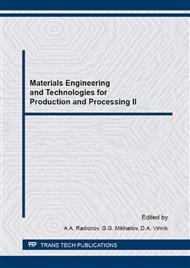[1]
D.N. Garkunov, Tribotechnology, Mashinostroenie, Moscow (1985).
Google Scholar
[2]
I.I. Novikov, Theory of heat treatment of metals, Metallurgy, Moscow (1978).
Google Scholar
[3]
E.A. Krivonosova, N.E. Semenova, Flame treatment materials, Perm, (2005).
Google Scholar
[4]
B.N. Arzamasov, V.I. Makarov, Materials science, Publ. house BMSTU, Moscow, (2002).
Google Scholar
[5]
Yu.M. Lahtin, B.N. Arzamasov, Chemical - heat treatment of metals, Metallurgy, Moscow, (1985).
Google Scholar
[6]
E.V. Dolbilin, A.V. Kokorin, New methods of chemical and heat treatment in an electric discharge, Tekhnologiya Mashinostroeniya. 6 (2004) 40-45.
Google Scholar
[7]
E.V. Dolbilin, A. Yu. Chursin, The electrical and technological characteristics of the non-self-discharge, Vestnik MEI. 1 (2001) 65-69.
Google Scholar
[8]
E.V. Dolbilin, Chemical heat treatment of metals in a pulsed electric discharge, Vestnik MEI. 2 (2002) 44-49.
Google Scholar
[9]
N.G. Kuhareva, M.A. Silenkov, S.V. ShuShkov, Chemical heat treatment in atmospheric pressure glow discharge, Metal science and heat treatment of metals. 1 (2002) 36-38.
Google Scholar
[10]
B.N. Arzamasov, A.E. Bratuhin, Ionic chemical heat treatment of alloys, Publ. house BMSTU, Moscow, (1999).
Google Scholar
[11]
A.A. Vedenov, G.G. Gladush, Physical processes in laser material processing, Energoatomizdat, Moscow, (1985).
Google Scholar
[12]
V. I. Mazhukin, M.V. Mazhukin, P. Berger, Kinetics of optical breakdown of aluminum vapor in wide frequency range, The current state of problems, Matematicheskoe modelirovanie. 17 (2005) 27-29.
Google Scholar
[13]
E.V. Danschikov, V.A. Dymshakov, F.V. Lebedev, Subsurface formation in a continuous beam СО2-laser, Izvestiya AN USSR. 49 (1985) 811-828.
Google Scholar
[14]
A.M. Prohorov, V.I. Konov, The interaction of laser radiation with metals, Science, Moscow (1988).
Google Scholar
[15]
A.N. Safonov, A.G. Grigoryanc, Laser heat treatment methods in engineering, Mashinostroenie, Moscow, (1986).
Google Scholar
[16]
L.N. Larikov, V.M. Falchenko, V.F. Mazanko, Anomalous diffusion acceleration under impact loading metal, DAN USSR. 221 (1975) 1073-1075.
Google Scholar
[17]
T.V. Mironova, D.S. Gercriken, A.M. Shterenberg, Features of interaction OCK- metals with carbon and nitrogen under shock compression, Problemy mashinostroeniya i avtomatizacii. 3 (2005) 66-72.
Google Scholar
[18]
T.V. Mironova, V.F. Mazanko, G.I. Prokopenko, Carbon interaction with iron and its alloys in ultrasonic shock treatment, Fizika i himiya obrabotki materialov. 3 (2006) 73-82.
Google Scholar
[19]
L.I. Fedorenkova, Features diffusion during processing of metals in the electrolyte reservoir, Vestnik Dnepropetrovskogo universiteta, seriya Fizika, Radioelektronika. 14 (2007) 34-37.
Google Scholar
[20]
G.N. Gavrilov, Design and development of technology of surface thermal hardening and cladding of metal material lasernym radiation, Dr. diss., N. Novgorod, (2000).
Google Scholar
[21]
D.S. Stavrev, Education and change of carbides in the iron-carbon alloys under the influence KPE, Metal science and heat treatment of metals. 11 (2003) 3-6.
Google Scholar


